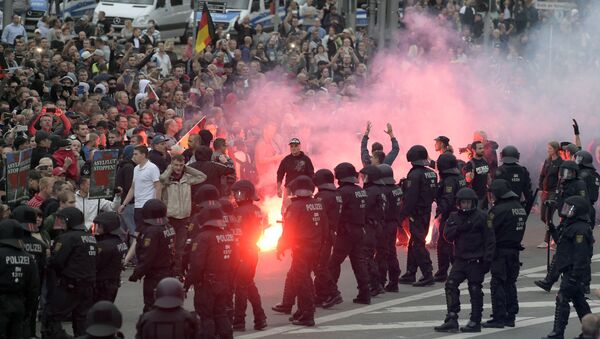German authorities are investigating the leak of an arrest warrant for one of the suspects in the Chemnitz killing, a 22-year-old Iraqi. The Chemnitz prosecutor's office has launched a probe, while Saxony’s general attorney has assigned Dresden’s prosecutor to find out who was responsible for the publication, which landed the German police in hot water just a day after clashes between right- and left-wing protesters there.
Earlier the Saxon Interior Ministry tweeted that it couldn’t yet comprehend where the images had come from. The authorities are currently checking the authenticity of the document, which contains the full names of the victims, the alleged perpetrators and the judge, as well as the suspect’s address and the witnesses’ names, which had been blacked out in early publications.
"We assume that this is genuine," the spokesman of Dresden’s prosecutor Lorenz Haase told the German outlet Tagesspiegel.
He emphasized that the publication on the Internet as well as breach of service secrets is being investigated. Those, who leaked the indictment or other official confidential documents related to the criminal proceedings before they had been disclosed, can face a year in prison or a fine.
The arrest warrant has been circulating on social media and messengers since the evening in August. It has been shared by anti-Islamization movement Pegida’s leader Lutz Bachmann and the right-wing group Pro Chemnitz, which was among organizers of the protests. However, the post was later deleted by the "Internet police," as the statement on the organization’s Facebook reads.
Prime Minister of the German state Saxony, Michael Kretschmer, who represents Angela Merkel’s Christian Democratic Union, called the leak a crime.
"If I hear that the arrest warrant was probably leaked from the police into right-wing extremist circles, we have a bigger problem to deal with," he told the local broadcaster MDR.
Federal Interior Minister Horst Seehofer (CSU) slammed the publication of the arrest warrant as "completely unacceptable." He emphasized that personal data as well as the actions of public authorities shouldn’t be outed this way.
Three Days of Unrest
The Chemnitz unrest broke out after Daniel H, a 35-year-old of German Cuban origin, was stabbed to death following a verbal confrontation on the sidelines of a public festival in the early morning of August 26. Two more people were wounded. A Syrian and an Iraqi in their early 20s have been arrested on suspicion.
On the day of the murder, around 1,000 people streamed into the streets. Some of them can be seen chasing people they believe to be foreigners. The rallies, which took the authorities by surprise, descended into chaos as riot police tried to contain the crowd later in the day.
READ MORE: Anti-Immigrant Protests in Germany: What Has Happened So Far (PHOTOS, VIDEOS)
The next day, the number of anti-immigrant protesters grew to 6,000 people, many of whom had traveled to Chemnitz from other states. Neo-Nazis and hooligans also turned up at the heart of the city, chanting "Foreigners out" and performing Hitler salutes, which are outlawed in Germany. The rallies grew into clashes after nearly 1,500 left-wing activists struck back at the anti-immigrant protesters. Police used pepper spray and water cannons against two large groups of demonstrators, who were throwing projectiles at each other, leaving 18 protesters from both sides as well as two police officers wounded.
On August 28, the Chemnitz protests moved away from the city, with left-wing activists hitting the streets of Dresden, Cologne, and Leipzig. In the videos circulated on social media, people can be seen calling to stop the violence and chanting "Nazis out!"


